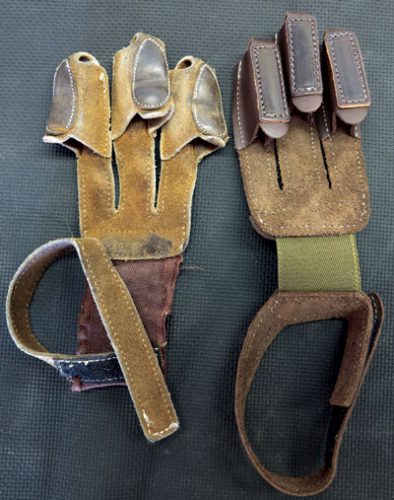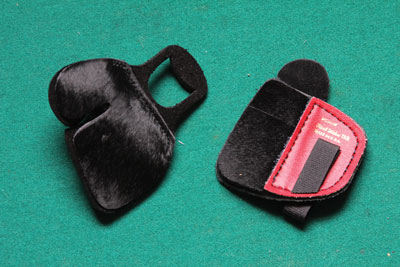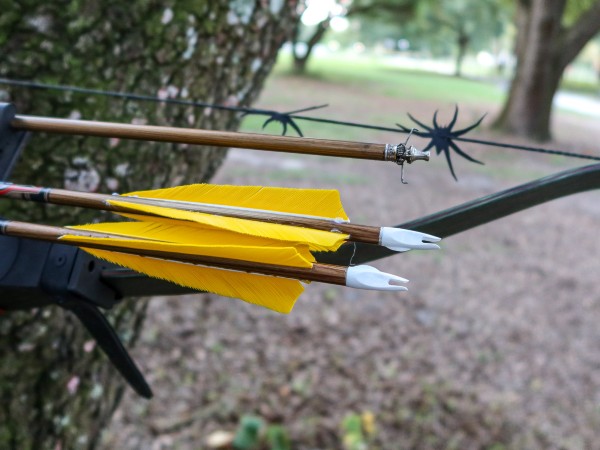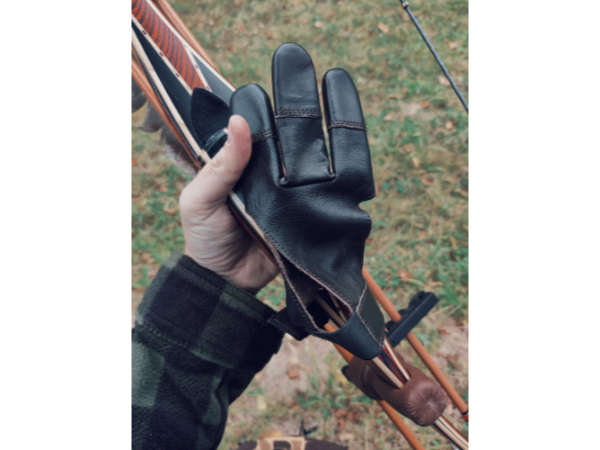While a few of us still shoot with bare fingers, most traditional bowhunters soon learn that archery is a lot more accurate and comfortable with something between the fingers of your dominant arm and the bowstring. The choices are pretty simple: tab or glove? Once that decision is made, not many change, and very few bowhunters go back and forth between the two. But which option should you choose in the first place?
In this column, we’ll ask two experienced advocates of each option to explain why they shoot with a tab or a glove.
Glove
The main reason why I shoot with a glove today is simple: That’s the way I’ve always done it.
When my kids were little, I put soft rubber slide-on finger guards (similar to Pine Ridge Finger Savers, from 3Rivers Archery, or No Glove, from Lost Nation) on their bowstrings. They didn’t provide a very crisp release, but the kids weren’t shooting at anything but targets, and I was tired of wasting time looking for the shooting gloves they seemed to lose about once a week. That option wasn’t even available back when I’d been their age.
I started out shooting with bare fingers when I was about six, but that hurt. Since I wasn’t about to stop shooting my bow, my folks bought me a soft leather shooting glove. That cured my sore fingers, although I lost my glove nearly as often as my kids lost theirs. I’ve been shooting with a glove ever since, and I know I’ll never change.
I’m not compulsive about most of my archery tackle. I can go back and forth between longbow and recurve and shoot arrows of different lengths and weights, but my shooting glove is part of me. I just can’t shoot with a tab, although friends who are better shots than I am swear by them. Occasionally, when I’ve lost my glove or inadvertently left it behind, I’ve borrowed a tab from one of them and tried to shoot with it. The results are always disastrous. It’s not a matter of compromised accuracy. It’s a matter of not being able to shoot the arrow past the shelf. Tabs are obviously fine for some people, but not for me.
There are many styles and models of shooting gloves out there, differing mostly in the stiffness of the leather, fit, and the means of fastening the glove to your hand. I personally like gloves like the Big Shot from America Leathers. The thick leather and stout construction of the fingertips provides a crisp, consistent release, and they are practically indestructible. I bought a backup some years ago and haven’t even broken it in yet. The old, reliable glove I’ve hunted with for decades just shows no sign of wearing out.
One advantage of a glove over a tab is the way I’ve adapted mine to perform in the cold. I do a lot of cold weather hunting, and I’ve listened to a lot of hunters complain about how hard it is to keep their hands and fingers working when temperatures drop below zero. I simply slide a fingerless woolen glove right over the top of my shooting glove. If that arrangement can’t keep my bowstring hand warm and functional, it’s too cold to be outdoors.
If you’re used to shooting a tab and are comfortable with it, the last thing I want to do is encourage you to switch to a glove. Nobody is going to get me to change my mind, and I don’t want to be responsible for getting you to change yours. However, if you haven’t committed to one option or another yet, I encourage you to consider the advantages of a glove.
At the end of the day, it all boils down to deciding what works best for you.
Don Thomas
Tab

This two-layer leather Kant Pinch tab has lost its slippery calf hair. Still, Wayne is loath to discard it.
Pain aside, releasing an arrow cleanly is easier if your fingers haven’t been pulped by previous shots. Archers who curl their knuckles around the string (there are other ways to draw and loose shafts) have for centuries protected them. England’s Privy Purse in 1534 records sums paid for “bowes, arrowes, shaftes, brode hedds, bracer and shooting glove for my lady Anne [Boleyn]….” Gervase Markham’s The Art of Archerie includes an illustration of an archer, circa 1650, wearing finger stalls.
In Longbow, author and authority Robert Hardy mentions instead the tab. “Now all you need is a string for the bow, a tab for your fingers, a bracer…and arrows.” Beyond its endearing simplicity, the tab is also effective. Replicas of longbows recovered from the Mary Rose, an English warship sunk during the Battle of the Solent in 1545, were stout. During shooting tests, Hardy photographed an archer drawing a 103-pound replica to thirty inches with a tab.
Stateside, the leather flap we know as a tab got little attention early on. Ishi, the Yana Indian who inspired his physician, Dr. Saxton Pope, to take up archery, used no finger protection. His 45-pound bow and Mongolian shooting style (the string held by his thumb) didn’t require it. In Hunting With the Bow and Arrow Pope wrote: “Doubtless the ancient yeoman, a horny-handed son of toil, needed no glove. But … even in those days a tab of leather was held in the hand to prevent the string from hurting. The glove is of more modern use ….” Pope noted a glove was “hot in hunting” and preferred stalls, which he described as tubular finger wraps not joined by straps. He recommended spares in case of loss.
Howard Hill favored stalls strung to a wrist band. So did protégé Bob Swinehart, a southpaw who took Africa’s “Big Five” with a longbow. Baleen inserts reinforced Swinehart’s stalls. Fred Bear, also left-handed, appears in photos with a shooting glove as early as 1927. A decade later he patented one!
A youngster awed by the exploits of these men, I chased their shadows with a hickory bow and, after it broke, a fiberglass Shakespeare bought with Green Stamps. I learned to use a tab because it came with that bow. Tabs then had two holes, for index and ring fingers, or for the index finger then third and fourth fingers together.
Tabs have evolved and proliferated. Popular wholesaler Lancaster Archery now catalogs nearly five pages of them! The two-hole tabs of my youth have been supplanted by those with a central hole or an elastic strap. You can get “three-under” tabs and tabs backed by alloy plates. Impressed by hyperbole? There’s a Black Mamba Venom Xtreme Universal…. Mercy.
My favorite tab is a two-layer NAM Kant Pinch with calf-hair face and suede back. The calf hair gives a smooth release, although my tabs stay in service long after the hair is gone. The spacer in Kant Pinch tabs (the design available from Legacy, Neet, and Bearpaw too) keeps middle and index fingers separated comfortably around the nock. A half-moon tongue behind the hole acts as a brake against the back of your finger. This tab won’t fall off on release or if you fold it against your palm to use your fingers for other tasks. You must specify size and right or left hand when ordering.
Yes, I’ve tried gloves. Great archers have used them. But decades of loosing shafts from a tab are hard to undo. I’ll change any part of my shooting routine to shoot better. The tab will remain.
Wayne van Zwoll
Glove

Having shot both tabs and gloves, T.J. prefers a glove. The well-used one on the left is an original Neet Archery leather shooting glove with cordovan reinforcements on the finger tips. The one on the right is made by Neet for Black Widow. It retains the cordovan, which allows for a smooth release, and is the model T.J. has been using for almost two decades.
If there is one thing bowhunters love to argue about, it is their equipment choices. If you were to ask a half dozen bowhunters sitting around a campfire which broadhead is best, most likely you will get a half dozen different answers. The same can be said about bows, quivers, camouflage (or no camo), ad infinitum.
But when it comes to what they use to protect their hands when drawing a bow, there are really only a few choices: tabs, gloves, and bare fingers…with the rare thumb ring shooter in the woodpile.
When I started shooting a bow back in the 1960s, I used bare fingers. The main reasons were my bows were quite light in weight, and I also did not know any better; sore fingers and blisters were quite common. Later, when I got serious about archery, I settled on the three-fingered shooting glove. Why? No real answer other than it seemed to be logical, I like shooting with one, and I found it more conducive to my shooting style. I can shoot with a tab, and have in a pinch, but I prefer the shooting glove. It fits my way of doing things, is easy to use, and gives me the confidence I need in the field.
Over the years I have shot almost every type of shooting glove there is: Damascus, Howard Hill strap glove, full-length leather gloves…I even made finger stalls like those Art Young and Saxton Pope used as shown on page 101 of Pope’s book Hunting with the Bow and Arrow. In the end, I chose to use the standard three-fingered, leather shooting glove.
After several years going through several shooting gloves, I happened upon one made by Neet Archery that had cordovan leather sewn over the finger stalls to add protection and give a better release than plain leather gloves. Cordovan, at one time, came from goat hide; however, today it is the thin, smooth leather from the hindquarters of horse hide. It is very smooth, does not crease as easily as standard leather, and allows for a very clean release.
Today, I use the same glove design, but with modifications. Black Widow Bows has redesigned the glove, which is custom made by Neet for Black Widow. I usually order five of them every other year, as I not only wear them out, but they also seem to lose themselves during my many days afield. Sometimes I think they are appropriated by certain friends, but I digress…
I have used this style of glove for decades in all sorts of climate conditions with very few issues. Having rather poor circulation in my hands can affect my ability to shoot in extreme winter weather; however, I developed a method many years back to adjust to this issue and still shoot with a glove. The Army/Navy surplus store in town sells wool military glove liners, which I prefer to use. For late season bowhunting, I cut three fingers off to the second knuckle, slip it over a thin Thinsulate or polypropylene glove, and wear my shooting glove over it. With a handwarmer in my coat pocket as a backup, I can still shoot with a glove when the temperatures drop well below freezing, and I don’t see myself changing any time soon.
T. J. Conrads
Tab

Finger tabs come in two basic types: split-finger (left) and three-under.
I can remember the exact moments when I changed several things about my shooting or equipment. My preference for shooting tabs is not one of them. When I first took up archery I was given a number of things by my father, including his old arm guard and shooting glove. The rock hard dark leather glove was older than me and consisted of well grooved finger stalls attached to a wrist strap. Eventually I bought a number of newer gloves of similar design, one with green dyed calf hair to make the release smoother. At some point I started shooting with tabs instead of gloves, and although I can’t remember why I initially switched, I can say definitively why I never switched back to gloves.
There is nothing wrong with using a glove if it works for you, but there are a few reasons why I’ve preferred a tab for the past three decades. First and most importantly, it allows me to feel my anchor point better. With skin-on-skin contact between my fingers and face, I can easily locate my exact anchor, which helps increase my accuracy. A small variation in anchor point is greatly magnified by larger groups downrange.
A finger tab is also very easy to get out of the way when I don’t need it by simply spinning it around to the backside of my hand. There’s no need to take it off as with a shooting glove. When I’m hunting, my finger tab spends more time behind my hand than in front of it.
Finger tabs are also small, which makes keeping an extra or two easy and convenient. Granted, the odds of losing a shooting glove are much lower due to it being firmly attached to one’s hand. But both tabs and gloves wear out or get damaged. During a tournament I usually keep at least two or three extras in my quiver. For hunting, I have at least one backup in my pocket.
Many types of tabs allow the adding or removing of layers for a truly custom feel. Some folks like a thin tab, others like one thicker. With some of today’s modular designs, the archer can mix and match layers to find the exact thickness and material that works best for them. I’m not aware of any shooting gloves that offer that level of adaptability.
The only downside I’ve seen to shooting tabs is that a lot of them require a significant break-in period. Some folks don’t mind this, but I personally want a tab that shoots the same out of the package as it will after several thousand shots. For this reason, I personally prefer tabs with multiple thin layers over a single thicker one. Either way, there is no shortage of excellent tabs on the market these days, one of which should suit your needs for consistency, reliability, and comfort.
Jason R. Wesbrock







I want to express my gratitude for this insightful article discussing the choice between using a glove or a tab in traditional archery. As someone who is new to the sport, I find this information extremely helpful in making an informed decision.
The personal experiences shared by the advocates of both the glove and the tab are valuable. It’s interesting to hear how the author’s experience with gloves began from a young age and has become a fundamental part of their archery practice. The mention of finger guards for children and the availability of different options in the market provides practical solutions for beginners like myself.
One question that arises from reading this article is whether there are specific factors to consider when choosing between a glove and a tab. Are there certain shooting styles or bow types that are better suited for one option over the other? Understanding the nuances and considerations that can influence the decision-making process would be beneficial for those of us who are still exploring our archery preferences.
Additionally, it would be interesting to hear from other archers who have transitioned from one option to another. What prompted them to make the switch, and how did it impact their shooting experience? Hearing different perspectives and the reasons behind their choices could provide valuable insights for those who may be open to trying a different method.
Overall, I appreciate the personal anecdotes and insights shared in this article. Thank you for shedding light on the glove versus tab debate and providing helpful information for individuals like myself who are navigating the world of traditional archery.
I made the switch from. Black Widow split finger tab due to dropping it out of a treestand setup. While having spun it around to the back of my hand to reach into a pack for a snack it flew off into the air. It was a well used tab and doing what it was intended for, but I thought when it landed on the ground that day, that it was the last time that was going to happen! Enter the Super Glove from Black Widow! I never looked back.
I started 49 years ago with a tab but, when I started hunting course, preparing my bowhunting future, someone told me : “True bowhunter use gloves for hunting”.
So, I started with glove. During 15 years, I used only the glove for hunting and tournaments. I tried a lot of different gloves and mostly use a Fred Bear Archery glove. It was the best for me. But, I don’t like to cut the fingers tips of my cold weather gloves and at same time, the other thing I was fighting all the time was, the glove fingers tips were turning and need to adjust.
One day, I found an old Kantpinch tab, and tried again. I was surprised how easy it was. And I think, no matter, I know now I’m a bowhunter. Since that time, I tried different brands also and finally the Black Widow Tab was the best. Still using it and another brand called Omnivore is really cool. No more trouble.
I have others friends looking at me, they tried the tabs an now they also them.
For me, the tab give a better slipping
I started on a glove 16 years ago, shooting split finger. Now I shoot three under with a tab and cannot go back. I found my anatomy preferred three under due to my index finger bending the way it does. While the change was an irritating process, I have gained accuracy far higher than I ever got out of a glove with a cleaner release and bringing the arrow closer to my eye for my split vision shooting. I still shoot split with a glove occasionally, I used to for an increase in distance, but nowadays I can gauge those 75-80 yard shots with my tab. Pick what is most comfortable and accurate and improve your skill in time.